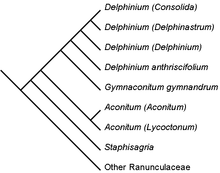Delphinium
Delphinium is a genus of about 300 species of annual and perennial flowering plants in the family Ranunculaceae, native throughout the Northern Hemisphere and also on the high mountains of tropical Africa. The genus was erected by Carl Linnaeus.[1]
All members of the genus Delphinium are toxic to humans and livestock.[2] The common name larkspur is shared between perennial Delphinium species and annual species of the genus Consolida.[3] Molecular data show that Consolida, as well as another segregate genus, Aconitella, are both embedded in Delphinium.[4]
The genus name Delphinium derives from the Ancient Greek word δελφίνιον (delphínion) which means "dolphin", a name used in De Materia Medica for some kind of larkspur.[5][6][7] Pedanius Dioscorides said the plant got its name because of its dolphin-shaped flowers.[8]
Species with short stems and few flowers such as Delphinium nuttallianum and Delphinium bicolor appear in habitats like prairies and the sagebrush steppe. Tall and robust species with many flowers, such as Delphinium occidentale, appear more often in forests.[9]
The leaves are deeply lobed with three to seven toothed, pointed lobes in a palmate shape. The main flowering stem is erect, and varies greatly in size between the species, from 10 centimetres in some alpine species, up to 2 m tall in the larger meadowland species.
In June and July (Northern Hemisphere), the plant is topped with a raceme of many flowers, varying in colour from purple and blue, to red, yellow, or white. The flowers are bilaterally symmetrical and have many stamens.[9] In most species each flower consists of five petal-like sepals which grow together to form a hollow pocket with a spur at the end, which gives the plant its name, usually more or less dark blue. Within the sepals are four true petals, small, inconspicuous, and commonly coloured similarly to the sepals. The uppermost sepal is spurred, and encloses the nectar-secreting spurs of the two upper petals.[10]



